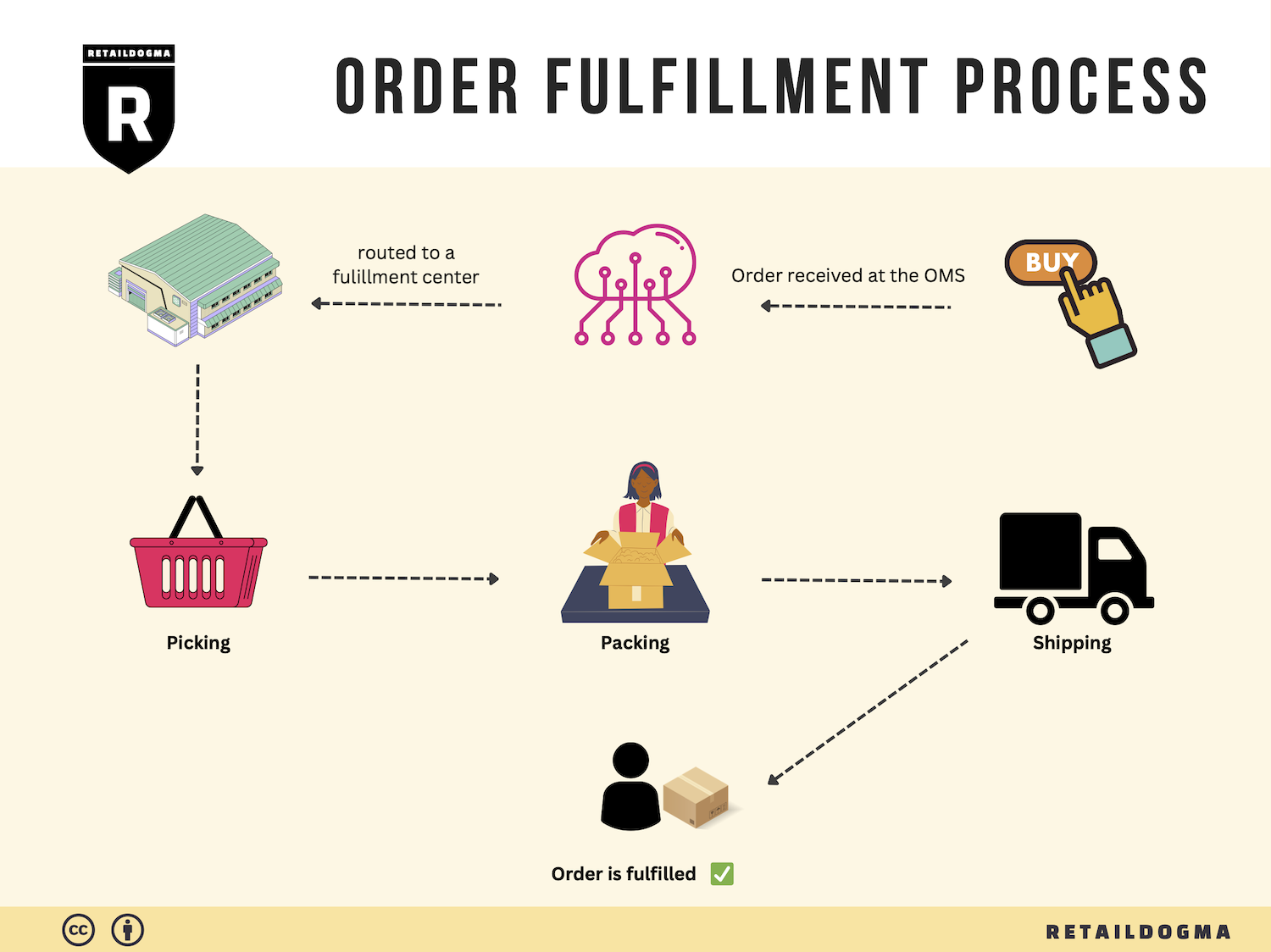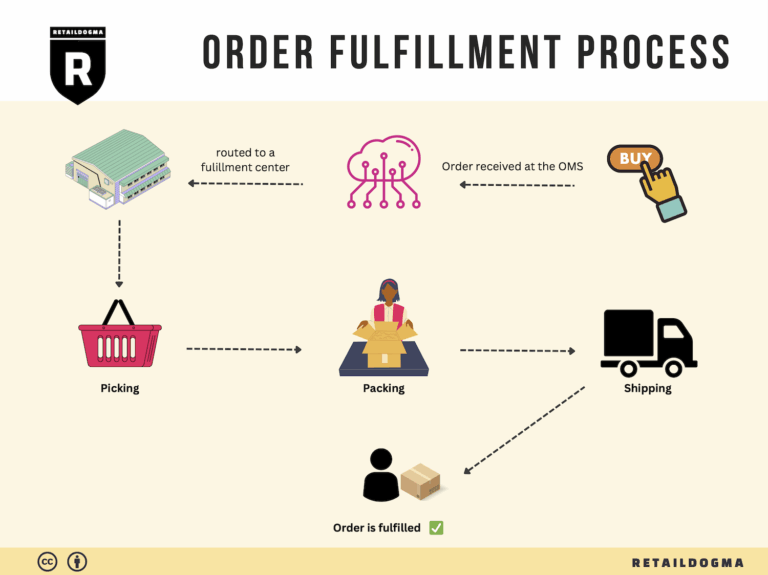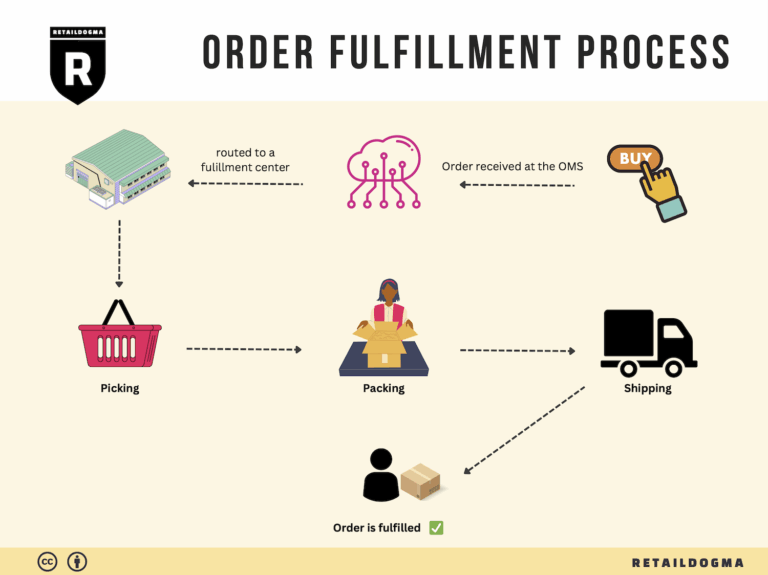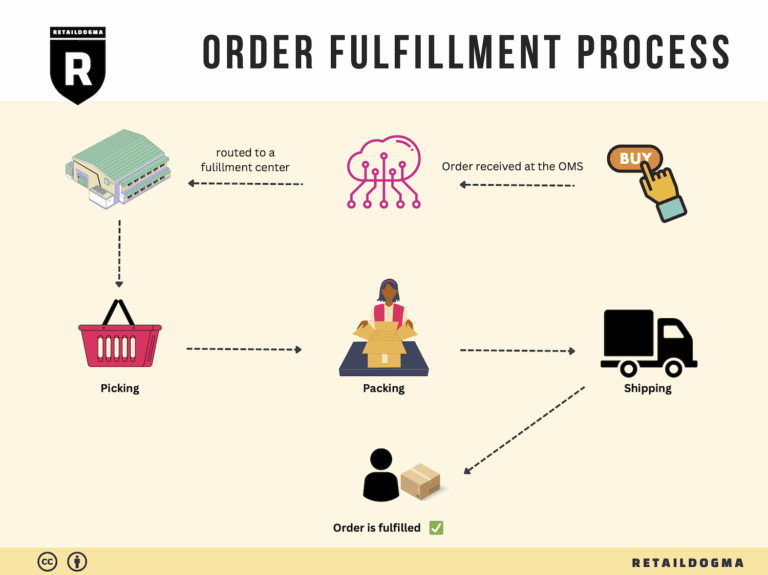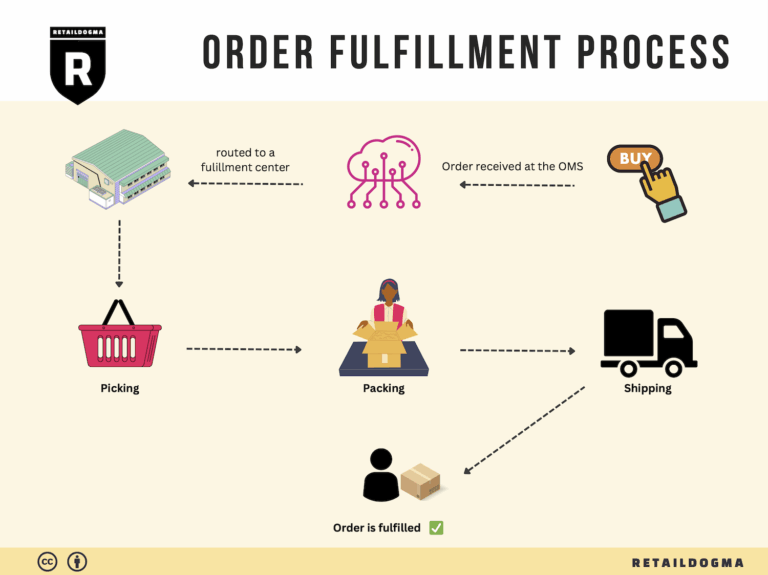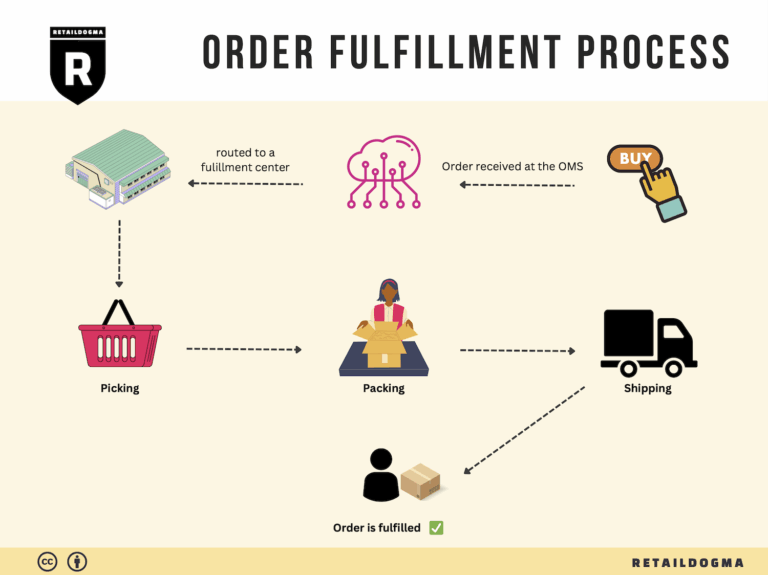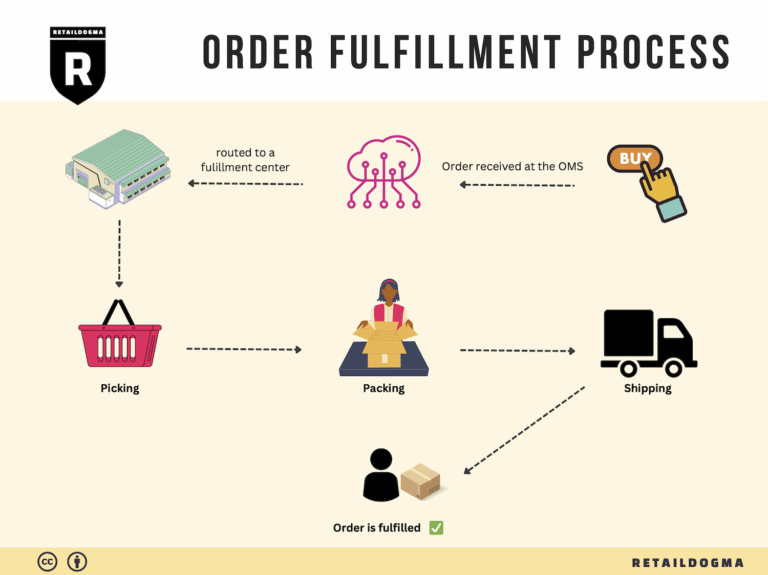Ecommerce Fulfillment Services: The Ultimate Guide (2025)
What is E-commerce Fulfillment? An Introduction for Growing Businesses
Understanding E-commerce Fulfillment
For many growing online businesses, the thrill of increasing sales can quickly turn into a daunting challenge when it comes to packing and shipping orders. The logistical complexities of fulfilling customer orders can overwhelm even the most organized entrepreneurs. As your sales grow, so does the volume of orders, leading to potential delays, inaccuracies, and customer dissatisfaction. This is where understanding e-commerce fulfillment becomes essential.
E-commerce fulfillment is simply the process of getting a product from your inventory to your customer’s doorstep. It encompasses everything from receiving and storing products to picking, packing, and shipping orders. This process can be intricate, especially as your business scales. Therefore, it’s crucial to have a clear strategy in place to manage these operations efficiently.
In this guide, we will explore various fulfillment models that can help streamline your logistics. You’ll learn about Third-Party Logistics (3PL) providers, which offer comprehensive services that can scale with your business needs, and Fulfillment by Amazon (FBA), which allows you to leverage Amazon’s vast logistics network. Each model has its own benefits and considerations, and understanding these will empower you to make the best choice for your business.
We will also delve into the core services offered by fulfillment centers, including inventory management, order processing, shipping, and returns handling. Each of these elements plays a critical role in ensuring that your customers receive their orders promptly and accurately.
Choosing the right fulfillment partner is another key topic we will cover. Factors such as location, technology integration, and service reliability are essential to consider when evaluating potential partners. A well-chosen fulfillment provider can enhance your operational efficiency and contribute to customer satisfaction.

Finally, we will discuss pricing structures associated with fulfillment services. Understanding how costs are calculated—whether through per-order fees, storage fees, or shipping costs—will help you budget effectively and optimize your profit margins.
The goal of this guide is to empower you with the knowledge necessary to make informed decisions about your logistics and fulfillment strategies. By understanding the options available and the intricacies of the fulfillment process, you can position your business for sustainable growth and success in the competitive e-commerce landscape.
What You’ll Learn In This Guide
- What is E-commerce Fulfillment? An Introduction for Growing Businesses
- The Order Fulfillment Process: From ‘Buy’ Button to Customer’s Door
- Comparing Fulfillment Models: In-House vs. 3PL vs. Dropshipping
- A Deep Dive into Amazon FBA: Pros, Cons, and Who It’s For
- Core Services Offered by Fulfillment Centers
- How to Choose a Fulfillment Partner: A 6-Point Checklist
- Understanding Fulfillment Pricing: A Breakdown of Common Fees
- Frequently Asked Questions (FAQs) about Fulfillment
- Conclusion: Is Outsourcing Fulfillment the Right Move for Your Business?
- Important Disclaimer
The Order Fulfillment Process: From ‘Buy’ Button to Customer’s Door
1. Receiving Inventory
The first step in the order fulfillment process is receiving inventory. This involves the arrival of products at the fulfillment center, such as the Amazon Fulfillment Center in Norwood, MA. Upon arrival, items are checked against the purchase orders to ensure accuracy. This process includes verifying quantities and inspecting for damages.
Why It’s Important: Proper receiving is crucial for maintaining inventory accuracy and preventing stock discrepancies. A well-managed receiving process helps businesses avoid stockouts and overstock situations, which can lead to lost sales or increased holding costs.
Key Term: SKU (Stock Keeping Unit) – This unique identifier for each product allows for efficient tracking and management of inventory throughout the fulfillment process.
2. Warehouse Storage
Once inventory has been received and verified, the next step is warehouse storage. Products are systematically stored in designated areas within the fulfillment center, utilizing space efficiently through strategic placement. This includes shelving systems that can accommodate varying product sizes and types.
Why It’s Important: Effective warehouse storage optimizes space and streamlines the retrieval process. By organizing products based on factors such as demand, size, and weight, businesses can enhance the speed and efficiency of order fulfillment.
Key Term: Bin Location – This refers to the specific location within the warehouse where a product is stored. By using bin locations, fulfillment centers can quickly locate items, reducing the time spent searching for products.

3. Order Picking
Order picking is the process of selecting items from the warehouse based on customer orders. This is often done using pick lists, which outline the items and quantities needed for each order. Fulfillment centers may employ various picking methods, such as single order picking or batch picking, to optimize efficiency.
Why It’s Important: The accuracy and speed of the picking process directly impact customer satisfaction. Delays or errors in picking can lead to incorrect orders being shipped, resulting in returns and diminished customer trust.
Key Term: Pick List – A document or digital tool that guides warehouse staff in selecting the correct items for an order. This helps ensure accuracy and efficiency in the picking process.
4. Order Packing
After items have been picked, the next step is order packing. This involves securely packaging the items for shipment, which may include adding protective materials, labeling, and preparing shipping documentation. The packing process is crucial for ensuring that products arrive at their destination in pristine condition.
Why It’s Important: Proper packing reduces the risk of damage during transit, which can lead to costly returns and customer dissatisfaction. Additionally, efficient packing processes can help minimize shipping costs by optimizing package size and weight.
Key Term: Packing Slip – This document accompanies the shipment and provides details about the contents of the package, including item descriptions, quantities, and any special instructions. It serves as a reference for both the shipper and the recipient.
5. Shipping & Delivery
The final step in the order fulfillment process is shipping and delivery. Once orders are packed, they are handed over to carriers for transportation to the customer. This stage involves selecting the appropriate shipping method based on factors such as cost, speed, and destination.

Why It’s Important: Timely shipping is essential for meeting customer expectations and maintaining a competitive edge in e-commerce. Delays in delivery can harm customer satisfaction and loyalty. Additionally, optimizing shipping routes and methods can help reduce costs and improve delivery times.
Key Term: Last Mile Delivery – This term refers to the final step of the delivery process, where the package is transported from a distribution center to the customer’s doorstep. Efficient last mile delivery is critical in ensuring timely and satisfactory service.
By understanding and effectively managing each of these five steps in the order fulfillment process, e-commerce businesses can enhance operational efficiency, reduce costs, and ultimately improve customer satisfaction. As a business scales, investing in technology and processes that streamline fulfillment will be key to sustaining growth and meeting increasing customer demands.
Comparing Fulfillment Models: In-House vs. 3PL vs. Dropshipping
Fulfillment Model Comparison
| Model | Who Handles Inventory | Best For (Business Stage) | Key Advantage | Key Disadvantage |
|---|---|---|---|---|
| In-House Fulfillment | The business itself | Established businesses with stable demand | Complete control over inventory and processes | High operational costs and complexity |
| Third-Party Logistics (3PL) | A third-party provider | Startups and growing businesses | Cost-effective scalability and expertise | Less control over inventory and processes |
| Dropshipping | Supplier or manufacturer | New businesses or niche markets | Low overhead and no inventory risk | Lower profit margins and potential quality issues |
In-House Fulfillment
In-house fulfillment involves managing the entire inventory and order fulfillment process within your business. This model is most suited for established businesses that have a stable demand and sufficient resources to handle logistics. Companies that choose in-house fulfillment gain complete control over their inventory, allowing them to manage stock levels, packaging, and shipping processes directly. This can lead to a more personalized customer experience, as businesses can tailor packaging and branding to their specifications. However, the key disadvantage lies in the operational costs; maintaining a warehouse, hiring staff, and investing in technology can quickly add up. Additionally, in-house fulfillment can become complex and cumbersome, especially during peak seasons or when dealing with fluctuating demand.
Third-Party Logistics (3PL)
Third-party logistics (3PL) involves outsourcing the fulfillment process to a specialized provider. This model is ideal for startups and growing businesses that need to scale quickly without the burden of managing logistics internally. Partnering with a 3PL allows businesses to benefit from established systems and expertise in inventory management, shipping, and compliance. For instance, a business in Norwood, MA, could leverage a 3PL like Buske Logistics to take advantage of their strategic location and fast shipping capabilities across the Northeast. The primary advantage of this model is cost-effective scalability; businesses can adjust their fulfillment needs based on demand without significant upfront investments. However, a potential downside is the reduced control over inventory and processes, which can lead to issues if the 3PL provider does not meet expectations in terms of service quality or compliance.
Dropshipping
Dropshipping is a fulfillment model where the retailer does not keep products in stock. Instead, when a retailer sells a product, they purchase the item from a third-party supplier who ships it directly to the customer. This model is particularly beneficial for new businesses or those operating in niche markets, as it requires minimal upfront investment and eliminates inventory risk. Retailers can offer a wide range of products without the need for a physical warehouse, allowing them to test new markets or products with limited financial exposure. However, dropshipping comes with its challenges, such as lower profit margins due to reliance on suppliers and potential quality control issues. Since the retailer does not handle the product directly, any mishaps in shipping or product quality could reflect poorly on their brand, making it essential to partner with reliable suppliers.
Conclusion
When considering which fulfillment model to adopt, e-commerce business owners must weigh their current operational capabilities, growth objectives, and customer expectations. Each model offers unique advantages and challenges, and the best choice often depends on the specific needs and circumstances of the business. For established companies with stable demand, in-house fulfillment may provide the control necessary for a tailored customer experience. Conversely, startups and businesses looking to scale quickly may find 3PL partnerships more advantageous, while dropshipping can serve as an excellent entry point for new entrepreneurs seeking to minimize risk. Ultimately, the right fulfillment strategy will align with the business’s goals, resources, and market demands, paving the way for sustainable growth in the competitive e-commerce landscape.
A Deep Dive into Amazon FBA: Pros, Cons, and Who It’s For
Understanding Fulfillment by Amazon (FBA)
Fulfillment by Amazon (FBA) is a service provided by Amazon that allows sellers to store their products in Amazon’s fulfillment centers. In return, Amazon takes care of storage, packaging, shipping, and customer service for these products. This service is designed to help sellers leverage Amazon’s vast logistics network to reach customers efficiently, making it an attractive option for many e-commerce businesses.
How FBA Works
-
Product Listing: Sellers begin by listing their products on Amazon. They can choose to enroll their products in FBA during the listing process.
-
Shipping to Amazon: Once a product is listed, sellers must ship their inventory to Amazon’s fulfillment centers. Amazon provides detailed guidance on how to package and label products for shipping.
-
Storage: Upon arrival, products are stored in Amazon’s warehouses. Sellers can track their inventory through the Amazon Seller Central dashboard.
-
Order Fulfillment: When a customer places an order, Amazon picks, packs, and ships the product directly to the customer. This process is streamlined to ensure quick delivery, often within two days for Prime members.
-
Customer Service: Amazon handles customer inquiries, returns, and refunds, allowing sellers to focus on other aspects of their business.
-
Payment: After the sale, Amazon deducts its fees from the proceeds and transfers the remaining balance to the seller’s account.
Pros of Using FBA
-
Prime Eligibility: Products fulfilled through FBA are automatically eligible for Amazon Prime, which can significantly increase sales. Prime members often prefer Prime-eligible products due to the fast shipping options.
-
Customer Trust: Leveraging Amazon’s brand enhances customer trust. Buyers are more likely to purchase from sellers using FBA because they know they will receive reliable shipping and customer support.
-
Multi-Channel Fulfillment: FBA allows sellers to fulfill orders not only from Amazon but also from other sales channels, such as their own website or other marketplaces. This can streamline logistics and improve efficiency.
-
Scalability: FBA enables businesses to scale quickly without needing to invest in warehousing or logistics infrastructure. As sales increase, sellers can send more inventory to Amazon without worrying about fulfillment logistics.
-
Time Savings: By outsourcing order fulfillment to Amazon, sellers can focus on marketing, product development, and other critical business operations, saving time and resources.
-
Advanced Logistics: Amazon’s sophisticated logistics and technology ensure that orders are processed quickly and accurately. This can improve overall customer satisfaction and reduce return rates.
Cons of Using FBA
-
High Fees: While FBA offers many advantages, it comes with significant costs. Sellers must pay storage fees for their inventory, fulfillment fees per item sold, and additional fees for long-term storage if products remain unsold for extended periods. These costs can eat into profit margins, especially for low-priced items.
-
Strict Inventory Rules: Amazon has stringent inventory management policies. Sellers must ensure that their inventory levels align with Amazon’s guidelines to avoid overstock penalties or stockouts, which can lead to lost sales.
-
Commingling Risks: When using FBA, sellers’ products may be commingled with inventory from other sellers. This can lead to issues if a customer receives a damaged or defective item, as it may be difficult to trace the source of the product. Additionally, sellers may face challenges with returns and refunds due to this commingling.
-
Limited Control Over Branding: When fulfilling orders through Amazon, sellers relinquish some control over the customer experience. Packaging and branding are standardized, which can dilute brand identity.
-
Complex Returns Process: While Amazon manages returns, sellers may face challenges if customers return items that were not in the original condition. This can lead to disputes and potential financial losses.
-
Dependency on Amazon: Relying on FBA can create dependency on Amazon’s platform and policies. Changes in Amazon’s algorithms, fees, or fulfillment policies can significantly impact sellers’ businesses.
Who is FBA Best For?
FBA can be an excellent option for a variety of businesses, particularly:
-
Small to Medium-Sized E-commerce Brands: Companies that lack the infrastructure or resources to handle logistics can benefit greatly from FBA, allowing them to focus on growth and customer acquisition.
-
Sellers with High Sales Volume: Businesses that can maintain a steady inventory and high sales volume may find that the benefits of FBA, such as Prime eligibility and fast shipping, outweigh the costs.
-
New Sellers: Entrepreneurs just starting out can leverage FBA to establish their presence on Amazon without the need for significant upfront investment in logistics.
-
Businesses Requiring Scalability: Companies experiencing seasonal spikes or rapid growth can use FBA to scale their operations quickly without worrying about fulfillment logistics.
-
Multi-Channel Sellers: E-commerce businesses selling on multiple platforms can streamline their logistics by using FBA for order fulfillment across various sales channels.
In conclusion, while FBA offers numerous advantages, including access to Amazon’s vast logistics network and enhanced customer trust, it also presents challenges, particularly in terms of fees and inventory management. Understanding these pros and cons is crucial for e-commerce businesses looking to leverage FBA effectively.
Core Services Offered by Fulfillment Centers
Inventory Management & Warehousing
Fulfillment centers provide comprehensive inventory management and warehousing services that are crucial for e-commerce businesses. This service involves the systematic storage, tracking, and organization of products within a warehouse environment. Advanced technologies, such as barcode scanning and warehouse management systems (WMS), are employed to maintain accurate inventory levels, ensuring that stockouts and overstock situations are minimized.
The benefits of effective inventory management are substantial. Firstly, it enhances operational efficiency by automating inventory tracking, which reduces manual errors and saves time. Real-time visibility into stock levels allows businesses to make informed purchasing decisions, optimizing their supply chain. Additionally, by centralizing inventory in a fulfillment center, businesses can reduce overhead costs associated with maintaining multiple storage locations, leading to significant cost savings. This streamlined approach not only improves order accuracy but also enhances customer satisfaction through timely deliveries.
Pick and Pack Services
Pick and pack services are a cornerstone of fulfillment operations, encompassing the process of selecting products from the warehouse and preparing them for shipment. This service typically involves picking items based on customer orders, packing them securely, and labeling them for delivery. Fulfillment centers utilize efficient picking methods, such as batch picking or zone picking, to maximize speed and accuracy.
For e-commerce businesses, the benefits of pick and pack services are multifaceted. By outsourcing this process to a fulfillment center, businesses can scale their operations without the need for additional labor or infrastructure. Fulfillment centers employ trained staff who specialize in optimizing the pick and pack process, leading to faster order fulfillment times. This speed is crucial in today’s e-commerce landscape, where consumers expect rapid delivery. Furthermore, accurate packing reduces the risk of returns due to incorrect items being shipped, thereby enhancing customer trust and loyalty.
Kitting and Assembly
Kitting and assembly services offered by fulfillment centers enable businesses to combine multiple products into a single package or kit. This could include assembling products that require various components, such as subscription boxes or promotional kits. Fulfillment centers can handle everything from simple bundling of items to complex assembly tasks, ensuring that the final product meets specific customer requirements.
The primary advantage of kitting and assembly services lies in their ability to streamline the order fulfillment process. By preparing kits in advance, businesses can reduce handling time during peak order periods. This not only accelerates the shipping process but also allows for better inventory management, as businesses can forecast demand for specific kits and plan their stock accordingly. Additionally, offering customized kits can enhance the customer experience, providing unique value that can differentiate a brand in a competitive market.
Returns Management (Reverse Logistics)
Returns management, often referred to as reverse logistics, is a critical service provided by fulfillment centers that focuses on handling product returns efficiently. This process includes receiving returned items, inspecting their condition, restocking them if applicable, and managing any necessary repairs or replacements. An effective returns management system ensures that customers have a hassle-free experience when returning products.
The benefits of robust returns management are significant for e-commerce businesses. A well-structured return process can enhance customer satisfaction, as consumers are more likely to purchase from brands that offer easy return options. Furthermore, effective returns management can help businesses recover value from returned products, whether through refurbishment, reselling, or recycling. It also provides valuable data insights into customer behavior and product performance, enabling businesses to make informed decisions about inventory and product offerings. By minimizing the costs associated with returns and maximizing the recovery of returned goods, fulfillment centers can significantly contribute to a company’s bottom line.
In conclusion, partnering with a fulfillment center offers e-commerce businesses a suite of core services that can enhance operational efficiency, improve customer satisfaction, and ultimately drive growth. From inventory management to returns processing, these services are designed to address the unique challenges faced by online retailers, allowing them to focus on scaling their business while ensuring that logistics are handled expertly.
How to Choose a Fulfillment Partner: A 6-Point Checklist
Location & Warehouse Network
Why It Matters:
The geographic location of your fulfillment partner’s warehouse significantly influences shipping times and costs. A strategically located fulfillment center minimizes transit times to your customers, which is crucial for maintaining customer satisfaction and loyalty. For businesses targeting a regional market, proximity to your customer base can be a game changer.
Questions to Ask:
– Where are the fulfillment centers located, and how do they align with my target market?
– What is the average shipping time to key markets from their warehouses?
– How many fulfillment centers do they operate, and are they expanding their network?
Technology & Integrations
Why It Matters:
A fulfillment partner equipped with advanced technology can streamline your operations, enhance order accuracy, and provide valuable insights into your inventory and shipping processes. Seamless integration with your existing e-commerce platforms (like Shopify, Amazon, or WooCommerce) ensures that your operations remain efficient and reduces the chances of errors.
Questions to Ask:
– What warehouse management systems (WMS) do you use, and how do they enhance fulfillment accuracy?
– Can your technology integrate with my existing e-commerce platforms? If so, what is the process?
– Do you provide real-time tracking capabilities for orders, and how can I access this information?
Specializations (e.g., Cold Storage, Oversized Items)
Why It Matters:
Not all fulfillment centers can handle every type of product. If your business deals with specialized items such as temperature-sensitive products or oversized goods, it’s essential to choose a partner with the right capabilities. This ensures compliance with regulations and maintains product integrity during storage and shipping.
Questions to Ask:
– Do you have the necessary facilities for my specific product types (e.g., cold storage for perishables, special handling for fragile items)?
– What certifications or compliance measures do you have in place for specialized storage?
– Can you provide examples of how you have successfully handled similar products for other clients?
Scalability & Capacity
Why It Matters:
As your business grows, your fulfillment needs will change. A partner that offers scalability can accommodate seasonal spikes or sudden growth without compromising service quality. Understanding their capacity to handle increases in order volume will help you avoid fulfillment delays that can harm your reputation.
Questions to Ask:
– How do you handle seasonal fluctuations in order volume?
– What is your current capacity, and how quickly can you scale up operations if needed?
– Are there limits on the number of SKUs you can manage, and how do you handle inventory overflow?
Pricing and Contracts
Why It Matters:
Understanding the pricing structure and contract terms is crucial for budgeting and financial planning. Hidden fees can erode your profit margins, so clarity on costs associated with storage, shipping, and additional services is essential. A flexible contract can also provide peace of mind as your business evolves.
Questions to Ask:
– What is your pricing model (e.g., per order, per pallet, storage fees), and are there any additional charges I should be aware of?
– Can you provide a detailed breakdown of costs associated with your services?
– What are the terms of the contract, and is there flexibility for adjustments as my business grows?
Customer Support & Reviews
Why It Matters:
Strong customer support can make a significant difference in your fulfillment experience. A partner that is responsive and proactive in addressing issues will help you maintain smooth operations. Additionally, checking reviews and testimonials from other businesses can provide insights into their reliability and service quality.
Questions to Ask:
– What type of customer support do you offer (e.g., dedicated account manager, 24/7 support)?
– How do you handle issues or disruptions in the fulfillment process?
– Can you provide references or case studies from other businesses similar to mine?
Conclusion
Choosing the right fulfillment partner is a critical decision that can significantly impact your business’s efficiency and growth potential. By considering these six key points—Location & Warehouse Network, Technology & Integrations, Specializations, Scalability & Capacity, Pricing and Contracts, and Customer Support & Reviews—you can make an informed decision that aligns with your business needs. Conduct thorough due diligence and engage in open conversations with potential partners to ensure they can meet your fulfillment requirements now and in the future.
Understanding Fulfillment Pricing: A Breakdown of Common Fees
Initial Setup Fees
Initial setup fees are one-time charges incurred when you begin using a fulfillment service. These fees cover the costs associated with onboarding your business into the fulfillment provider’s system. This may include setting up your account, integrating your e-commerce platform (such as Amazon, Shopify, or WooCommerce), and configuring inventory management systems.
The calculation of initial setup fees can vary significantly between providers. Some may charge a flat rate, while others may base fees on the complexity of the integration or the size of your inventory. For instance, a business with a large SKU count may incur higher setup fees due to the increased time and resources needed to configure their systems. When evaluating fulfillment services, it’s essential to clarify what is included in the setup fee to avoid unexpected costs.
Receiving Fees
Receiving fees are charged for the process of accepting and logging your inventory into the fulfillment center. This includes unloading shipments, inspecting items for damage, and entering them into the warehouse management system (WMS).
Typically, receiving fees are calculated based on the volume of goods received, often measured in pallets or individual items. For example, a fulfillment center might charge a per-pallet fee or a flat rate for every 100 items received. It’s important to understand that this fee can vary based on the complexity of the receiving process; for example, items requiring special handling or inspection may incur higher fees.
Storage Fees (per pallet/bin)
Storage fees are recurring charges for keeping your inventory in the fulfillment center. These fees are usually calculated on a monthly basis and can be based on the space your inventory occupies, often measured in pallets or bins.
For instance, a fulfillment center may charge a standard monthly fee per pallet stored. This fee can be influenced by factors such as the type of product (e.g., perishables may have different rates) and the duration of storage. Some providers also impose additional fees for long-term storage if inventory remains unsold for an extended period, typically over six months. Understanding the storage fee structure is crucial for managing your inventory effectively and controlling costs.
Pick & Pack Fees (per item/order)
Pick and pack fees are charged for the labor involved in selecting items from the warehouse and preparing them for shipment. This process includes picking the correct products, packing them securely, and labeling packages for delivery.
These fees can be calculated in different ways. Some fulfillment centers charge a flat fee per order, while others charge based on the number of items picked and packed. For example, a provider may charge a base fee for the first item and a smaller fee for each additional item. It’s essential to assess how your order volume and item variety will impact these fees, especially if your business experiences fluctuations in order size.
Shipping Fees
Shipping fees are among the most significant costs associated with fulfillment services. These fees cover the transportation of packages from the fulfillment center to the customer. Shipping fees can vary based on several factors, including package weight, dimensions, shipping distance, and the chosen shipping method (standard, expedited, etc.).
Many fulfillment centers offer discounted shipping rates due to their bulk shipping agreements with carriers. It’s advisable to ask about these rates during negotiations, as they can lead to substantial savings for your business. Additionally, some providers may offer flat-rate shipping options, which can simplify budgeting for shipping costs.
Tips for Getting an Accurate Quote
-
Be Detailed: When requesting a quote, provide detailed information about your business needs, including SKU counts, average order sizes, and expected order volumes. The more information you provide, the more accurate the quote will be.
-
Understand Fee Structures: Ask potential fulfillment partners to explain their fee structures thoroughly. Clarify any potential hidden fees, such as long-term storage or special handling charges.
-
Compare Providers: Don’t settle for the first quote you receive. Compare multiple providers to understand the market rates and services offered. Look for value rather than just the lowest price.
-
Negotiate Terms: If you find a provider that meets your needs but their fees are higher than expected, consider negotiating terms. Many providers are willing to adjust pricing or offer discounts for higher volumes or long-term contracts.
-
Request a Trial Period: If possible, negotiate a trial period to assess the fulfillment service’s performance and associated costs before committing long-term. This can provide insights into actual expenses and service quality.
By understanding the common fulfillment pricing models and following these tips, you can make informed decisions that align with your business goals and budget.
Frequently Asked Questions (FAQs) about Fulfillment
1. What is the Amazon Fulfillment Center in Norwood?
The Amazon Fulfillment Center in Norwood, located at 750 Everett St, serves as a pivotal hub for storing and shipping a wide array of products. It operates with advanced technology and logistics practices to ensure efficient order processing and timely delivery to customers across the region.
2. How does the fulfillment process work at Amazon’s Norwood facility?
The fulfillment process at the Norwood center involves several key steps: receiving inventory, storing products in a meticulously organized warehouse, picking items based on customer orders, packing them securely, and shipping them out using various carriers. The facility employs sophisticated inventory management systems to maintain accuracy and efficiency throughout the process.
3. What is the difference between a warehouse and a fulfillment center?
A warehouse primarily focuses on storing products, often for long-term use or bulk inventory. In contrast, a fulfillment center is designed to handle the entire order fulfillment process, including picking, packing, shipping, and managing returns. Fulfillment centers are typically more technologically advanced to facilitate quick order processing and delivery.
4. What is a 3PL (Third-Party Logistics) provider?
A 3PL provider offers outsourced logistics services, including warehousing, transportation, inventory management, and fulfillment. Businesses partner with 3PLs to streamline their supply chain, reduce costs, and improve delivery times without the need to manage logistics in-house.
5. How much do fulfillment services cost?
Fulfillment service costs can vary widely based on several factors, including order volume, storage space required, type of products, and specific services needed (like kitting or special packaging). Generally, costs may include per-order fees, storage fees, and shipping costs. It’s advisable to request quotes from multiple providers to find a solution that fits your budget.
6. What are the advantages of using the Amazon Fulfillment Center in Norwood for my business?
Utilizing the Amazon Fulfillment Center in Norwood offers several advantages, including access to a vast shipping network, fast delivery times (often 1-2 days across the region), and the ability to scale operations quickly during peak seasons. The center’s strategic location also helps reduce shipping costs and improve customer satisfaction.
7. How can I ensure my products are compliant with Amazon’s fulfillment requirements?
To ensure compliance with Amazon’s fulfillment requirements, businesses should familiarize themselves with Amazon’s guidelines regarding labeling, packaging, and shipping. Utilizing a 3PL provider that specializes in Amazon compliance can help manage these requirements effectively, reducing the risk of chargebacks and delays.
8. What challenges might businesses face when using the Norwood Fulfillment Center?
Common challenges include inventory inaccuracies, stockouts, high shipping costs, and difficulty managing multi-channel orders. Partnering with a reliable 3PL provider can help mitigate these challenges by offering advanced inventory management systems, competitive shipping rates, and streamlined order processing.
9. Can I integrate my existing e-commerce platform with the Norwood fulfillment services?
Yes, many fulfillment centers, including the one in Norwood, offer integrations with popular e-commerce platforms like Shopify, Amazon, and WooCommerce. This allows for seamless order processing and inventory management, enabling real-time tracking and updates across your sales channels.
10. What should I consider when choosing a fulfillment provider in Norwood?
When selecting a fulfillment provider, consider factors such as their location, shipping capabilities, technology infrastructure, customer service, and experience with your specific type of products. Additionally, assess their scalability to accommodate your business growth and seasonal fluctuations.
Conclusion: Is Outsourcing Fulfillment the Right Move for Your Business?
Weighing the Benefits of Outsourcing Fulfillment
Outsourcing your fulfillment operations can be a transformative decision for your business, especially as you strive to scale. One of the most significant advantages of partnering with a fulfillment service is the time savings it offers. By offloading logistics management, inventory control, and shipping processes, you can redirect your focus toward core business activities such as marketing, product development, and customer engagement.
Scalability is another critical benefit. As your business grows, so do the complexities of order fulfillment. A dedicated fulfillment partner can seamlessly adjust to fluctuations in demand, whether it’s handling seasonal spikes or accommodating rapid growth. This flexibility allows you to maintain service quality without the operational headaches associated with in-house logistics.
Moreover, leveraging the expertise of a third-party logistics (3PL) provider can help you navigate the intricacies of modern e-commerce. With specialized knowledge in compliance, inventory management, and shipping efficiencies, a well-chosen partner can enhance your operational capabilities while mitigating risks associated with logistics.
However, the key to unlocking these benefits lies in selecting the right fulfillment partner. It’s crucial to evaluate potential providers based on their experience, technology, and alignment with your business goals. A partner with industry-specific expertise can offer tailored solutions that meet your unique needs, ultimately fostering growth.
Take Action
To determine if outsourcing fulfillment is the right next step for your business, conduct a thorough audit of your current shipping and logistics processes. Assess factors such as delivery speed, cost efficiency, and scalability challenges. This evaluation will provide valuable insights and guide you toward making informed decisions that can propel your business forward. Don’t hesitate—explore your options and consider how a strategic fulfillment partnership could be a game-changer for your growth trajectory.
Important Disclaimer
⚠️ Important Disclaimer
The information in this guide is for educational purposes. Fulfillment services, pricing, and platform features change frequently. Always conduct your own due diligence and consult with providers directly before making business decisions.
